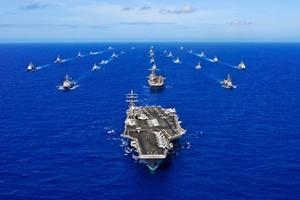In the trenchesLooming sequestration causes Navy to looking at future technology, fleet size
Adm. Mark Ferguson, vice chief of naval operations, offered a revealing look at the potential future for the Navy if sequestration, or automatic defense cuts, goes into effect in January; without some sort of adjustment by Congress, currently the subject of discussion on Capitol Hill, the nearly 10 percent across-the-board Department of Defense budget cuts are slated to commence in 2013 and continue for ten years

Sequestration places U.S. Navy assets in jeopardy // Source: herald-today.com
Adm. Mark Ferguson, vice chief of naval operations, headlined the opening of the ONR (Office of Naval Research) Naval S&T (science and technology) Partnership Conference and ASNE Expo on 22 October, and highlighted the importance of innovative S&T programs being developed by the Navy. He also offered a revealing look at the potential future for the Navy if sequestration, or automatic defense cuts, goes into effect in January.
Speaking to a capacity crowd as keynote speaker, Ferguson said the Navy is already working hard to do more across the globe-with less resources.
“The implications of trying to absorb a 9.4 percent cut on top of the significant reductions we’ve already done in fiscal year 2013 budgets, will have a very significant impact on the workforce, on the research and development (R&D) accounts — on everything,” said Ferguson.
The ONR release reports that Ferguson’s wide-ranging talk addressed an array of topics relating to ONR’s work in S&T research. The vice chief applauded ONR-led efforts to improve soldiers capabilities in programs such as the Electromagnetic Railgun, ballistic missile defense, cyber defense, and more.
These kinds of technologies, he said, are “game-changers,” and in spite of current fiscal austerity, he stressed that the Department of Navy’s leadership recognizes the importance of S&T research for the future of the service.
“We’re going to be smaller as we go forward,” he said, regardless of whatever decisions are made on sequestration. “We’re going to be leaner. But in the same breath we have to be technologically advanced. We have to make sure that we put the best technology we have into the hands of our warfighters. That’s our promise to future generations.”
Without some sort of adjustment by Congress, currently the subject of discussion on Capitol Hill, the nearly 10 percent across-the-board Department of Defense budget cuts are slated to commence in 2013 and continue for ten years.
The admiral stated he is personally hopeful lawmakers will moderate the cuts before they kick in, but noted that if no adjustments are made, the long-term as well as immediate effect on the Navy will be heavy.
“If you project out ten years — remember the budget control act talks about ten years of reductions — now you start talking about a fleet reduced to about 230-235 ships,” he said. “Now you start talking about reduction of manpower commensurate with that. Now you start talking about the reduction of money going to warfare centers, to R&D efforts.”
Ferguson’s talk also emphasized the Navy’s commitment to promoting programs aimed at getting young people involved in science, technology, engineering and mathematics (STEM) careers.
He said he will chair a committee to bring together industry, academic and service leaders to coordinate STEM support.
The release notes that the S&T conference is a biennial event bringing together top military, scientific, industry, and academic experts in matters related to science and technology and defense. More than 1,500 attendees registered for the event.
